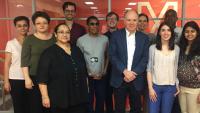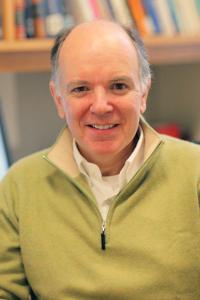Przedborski Lab

Principal Investigator
Serge Przedborski has pioneered the investigation of molecular mechanisms of neuronal death in the MPTP model of Parkinson's disease (PD) and in the mutant superoxide dismutase model of amyotrophic lateral sclerosis (ALS). He has demonstrated the importance of the cascade of deleterious events—oxidative stress, inflammation and apoptosis—in the demise of nigral dopaminergic neurons in PD and of spinal cord motor neurons in ALS.
The research conducted in my laboratory is geared toward unraveling the molecular basis of neurodegeneration and devising therapeutic strategies to hamper the processes that cause neuronal death, the source of many debilitating disorders.
To that end, my laboratory has concentrated its research efforts on the MPTP mouse model of Parkinson's disease (PD) and on the mutant superoxide dismutase-1 (mSOD1) mouse model of amyotrophic lateral sclerosis (ALS). For the past decade, we have contributed significantly to the understanding of the molecular mechanism of MPTP neurotoxicity and consequently, the pathogenesis of PD. For instance, this laboratory has demonstrated that following the administration of the neurotoxin MPTP, the demise of the nigral dopaminergic neurons (the hallmark of PD) depends on the production of the reactive species, nitric oxide (NO), which originates in neighboring neurons and glial cells.
We have also demonstrated that NO does not cause damage directly but rather by reacting with another reactive species superoxide to produce peroxynitrite—the actual culprit. We have shown that peroxynitrite, once produced, inflicts severe damage on cell proteins and DNA. It is likely that cell death results not only from these injuries, but from apoptosis as well. Apoptosis, which is a form of programmed cell death, also appears to play a major role in the degeneration of spinal cord motor neurons in ALS. This view is supported by several recent publications from our laboratory. For example, it appears that the expression of key molecular apoptotic factors are altered in transgenic mSOD1 mice in a way that promotes cell death.
Through genetic and pharmacological interventions aimed at alleviating these noxious changes, one of our teams was able to prolong survival and attenuate neuronal death in this mouse model of ALS. They have demonstrated that this beneficial effect is, in part, mediated by the prevention of the release of cytochrome c from the mitochondria, which triggers a cascade of deleterious events implicated in the death of motor neurons.
Lab Members
Peter Barbuti, PhD
- Associate Research Scientist
Investigating the role of alpha-synuclein in patient-derived neurons modeling Parkinson's disease.
Matthew Jennings, PhD
- Postdoctoral Research Scientist
Implementation of emerging genetic engineering techniques for studying neurodegenerative disease in vivo.
Oliana Stange
- Undergraduate Research Student, Barnard College
Irina Utkina-Sosunova, MD, PhD
- Associate Research Scientist
Developing cellular models for high-throughput screening of neuroprotective biomolecules for chemotherapy-induced peripheral neuropathy (CIPN). Investigation of pathogenetics of ALS and PD in rodent models and in post-mortem patient tissue.
Select Publications
Prou D., Jackson-Lewis V., Vila M., Burke R., Przedborski S. Implication of COX-2 in programmed cell death induced by MPTP. Society for Neuroscience Annual Meeting. Atlanta, Georgia, October 2006.
Re, D.B., Przedborski S., Astrocytes expressing ALS-linked mutant SOD1 are selectively toxic to wild-type embryonic primary and stem cell-derived motor neurons. Society for Neuroscience Annual Meeting. Atlanta, Georgia, October 2006.
Zhou C., Perier C., Huang Y., Hirano M., Przedborski S. Topology of PINK1 in mitochondria. Society for Neuroscience Annual Meeting. Atlanta, Georgia, October 2006.
Wu D., Re D.B., Nagai M., Jackson-Lewis V., Ischiropoulos H., Przedborski S. Extraneuronal ROS modulates growth factor/Akt survival pathway in ALS mice. Society for Neuroscience Annual Meeting. Atlanta, Georgia, October 2006.
Yamashita S., Almer G., Kikuchi H., Guegan C., Nagai M., Xu Z., Sosunov A.A., McKhann G.M., Przedborski S., Spinal cord endoplasmic reticulum stress associated with a microsomal accumulation of mutant SOD1 in an ALS model. Society for Neuroscience Annual Meeting. Atlanta, Georgia, October 2006.
Przedborski S. Interplay between Oxidative Stress and Inflammation in Parkinson’s disease. Radicals in Heart and Mind at the Buck Institute. Novato, California, October 2006.
Przedborski S. What Makes the Disease Progress. World Parkinson Congress Meeting. New York, New York February 2006.
Przedborski S. Inflammation in Parkinson’s disease. US Army NETRP Integration Mtg. Parkinson’s Disease Meeting Series. Las Vegas, Nevada, November 2005.
Przedborski S. Immune and inflammatory changes in Parkinson’s disease. Models of Motor Neuron Diseases. Ettore Majorana Centre for Scientific Culture. The Neurodegenerative Process: Biology, Models and Diseases. International School of Medical Sciences. Erice, Sicily, October 2005.
Przedborski S. Parkinson’s Disease: Mechanisms and Models. GTCbio Therapeutic Strategies against Neurodegenerative conditions. Burlington, Massachusetts, October 2005.
Przedborski S. A pathogenic oxidative stress in Parkinson’s disease: A myth or a reality? Nebraska Redox Biology Center Symposium. University of Nebraska-Lincoln, September 2005.
